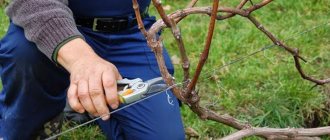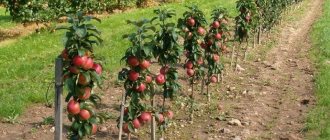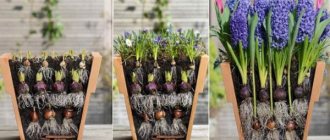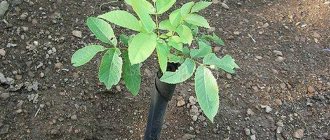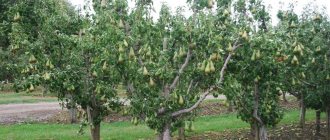When is the best time to plant?
Rooting grape seedlings is a special chapter in plant cultivation. There are supporters of spring planting, and there are also supporters of planting grapes in the fall. Both terms have their pros and cons, their subtleties and details.
Let's figure out when it is better to plant grapes: in autumn or spring.
Among the advantages of planting grapes in the spring are:
- faster rooting in warm conditions;
- wet soil after snowmelt;
- less risk of frost.
Disadvantages of spring planting:
- difficulties in selecting quality seedlings, since most of them are sold out in the fall;
- the need for additional preventive soil treatments against pests and fungal infections;
- the risk of sudden night frosts that can destroy a young plant.
Positive points when planting in the fall:
- large selection of good seedlings;
- varietal diversity;
- soil moistened with rainwater;
- high survival rate;
- stronger plants during the growing season, resistant to pests and diseases.
Gardeners highlight the following disadvantages:
- risk of seedlings freezing;
- risk of cold snaps;
- risk of a cold winter with little snow.
Planting material
Planting material
The choice of seedlings is no less important than the time of planting, the condition of the soil, correctly dug holes and selected high-quality fertilizer.
Proper care only keeps the plantings in good condition , and no matter what it is, if the planting material is of poor quality, you should not eat too much and wait for a good harvest.
Depending on the work done, there are two types of planting material:
- Lignified seedlings are one-year-old bushes that were dug up in the autumn and left in wet sand.
- Chubuki are vegetative green seedlings that were planted in early spring and have their own leaves when planted. They are obtained after pinching or breaking off.
Properly selected seedlings are the key to a good vineyard.
How to choose seedlings?
Before planting seedlings in open ground, you need to select them correctly. This is one of the most important stages of the entire process, and here you should know several very important nuances:
- The main roots on the stem are dense, thick, elastic, at least 3-4 pieces, moist when cut.
- Small roots in large quantities.
- The barrel is intact, without cuts, cracks, or scratches.
- One or two vines, brown, with 3-5 buds.
- The length of the seedling itself should be in the range from 30 to 40 cm, while the thickness is 3-5 mm.
Rules for selecting cuttings
Careful selection of cuttings (chubuks) before planting them in the ground takes place according to the following characteristics:
Cuttings with root system
- A healthy vine with no signs of disease or damage.
- The bark is light brown or sand-colored, green when cut.
- The diameter of the vine is about 1 cm, but not thicker than 12 mm.
- Length – about 0.5 m, with 3-5 buds.
- Cuttings without roots must be rooted, i.e. plant in such a way as to allow them to establish themselves in the soil or root in a glass container (for example, such as a jar) with water.
- Chubuki with a root system must have at least 3-5 healthy strong roots.
We figured out how to select seedlings and cuttings. Next, we will describe in more detail how to plant grapes with cuttings and seedlings so that they take root better.
Planting grape seedlings
When planting plants, the following conditions must be observed:
- adhere to the required planting depth;
- correct location of the upper eye of the vine trunk.
The process of planting seedlings requires careful compliance with the necessary conditions:
- A chernozem layer is poured onto the prepared soil (soil, manure, wood ash), without any additives. This is a buffer layer that allows you to avoid possible damage to the root system of the plant by fertilizers. The plant is planted on this newly created soil layer, carefully placing the roots in a cone shape and spreading them along the diameter of the planting hole as evenly as possible.
- The “heels” of the seedlings are placed in the southern side of the hole, at a depth of about 50 cm. The upper eye of the seedling shoot should be approximately 15 cm below the ground level. In addition, when tilting the plant, you should position the eye of the future shoot in the direction from north to south.
- Gradually pour soil into the holes without touching the shoots. The layer of soil around the vine is compacted. Newly planted seedlings must be watered abundantly (up to 30 liters per root). When all the water is completely absorbed by the soil, you need to add a layer of soil into the hole to the previous level (compacting the soil is not necessary).
- The top layer of soil, after drying, is loosened.
Some gardeners mistakenly believe that if you plant plants in moist soil, for example, during or after rain, then watering is not necessary, but this is not true. To eliminate the formation of air tunnels in the soil layer, watering the grapes is vital. Otherwise, the contact of the plant root system with the ground will be disrupted.
Tip: each seedling must be watered at least 2 times before the onset of frost. For this procedure, you can use a drainage pipe; in this case, there is no need to loosen the soil.
Process
Organizing and choosing the right place for planting is an important stage in the formation of the future vineyard, as is the preparation of planting material.
Important! Preparations begin several months before the intended planting - the soil is fertilized as necessary, supports are placed for future bushes, and holes are prepared.
In the process of preparing for planting, it is necessary to answer three main questions: how, when and where to plant?
Preparation of material
Seedlings or chubuks are prepared 2 days before planting:
- the main lower roots are trimmed by 1-2 cm;
- the top of the vine is trimmed by a few millimeters;
- the plant is immersed in water at room temperature overnight;
- Additionally, you can soak the roots in a solution of growth stimulants according to the instructions for the drug.
Pit
Diagram of a pit for planting grapes
The dimensions of the pit depend on the size of the root system of the seedlings; they can range from 40*40*40 cm to 1*1*1 m.
Preparation is carried out in advance - at least 3 weeks before the intended planting. This is necessary so that by the right time the soil has settled sufficiently and the seedlings or cuttings do not go too deep into the ground.
If possible, a hole is dug in the spring for autumn planting of grapes. When digging a hole, the top layer (20-30 cm) is set aside, as it will be useful for burying the roots of seedlings.
Important! If the groundwater level is high (above 2 meters), drainage is laid at the bottom of the hole - broken brick, expanded clay, etc.
Top dressing
When digging a hole or trench in the fall, any rotting organic remains are brought into it - last year's foliage, tops of tomatoes and potatoes, pruned branches of fruit trees. To speed up the process, special drugs are added.
You can add an infusion of chicken manure or cow manure into the hole as a top dressing just before planting. It is important that the organic matter is rotten - fresh organic matter can lead to burns of the root system and death of seedlings.
Before planting, 150-300 grams of superphosphate are also added to the hole - young grapes need phosphorus for good rooting, subsequent growth and development of the vegetative part. The addition of 100-200 grams of potassium sulfate will benefit the seedlings. As a source of microelements, wood ash is added to the bottom of the hole.
To get along better
- Water with 1-2 buckets of water once a week until regular rainfall occurs.
- Spray with potassium fertilizer when green leaves appear.
- Cover with a plastic bottle for the winter.
- Treat the roots before planting with root formers.
- Treat the soil with antifungal drugs.
- Choose local grape varieties.
Deadlines
The timing of planting grapes depends on the climatic conditions of the region. On average, the most favorable month for the procedure is the first and second ten days of October, when the air temperature does not rise above +15 and does not fall below +5.
Important! If there is a danger of early frosts, planting can be done earlier or postponed until spring.
Shelter for the winter
When stable negative temperatures arrive, cover the newly planted grapes with a trimmed five-liter bottle or an inverted bucket . Pour a mound of earth or a layer of organic matter 15-20 cm high on top.
To prevent the mound from being washed away by winter precipitation, it can be additionally covered with roofing material or film. In such a “house” the young grape seedling remains until spring.
And as soon as the snow melts, the grapes are gradually opened and sprayed against diseases and pests according to technology.
Features in regions
Vineyards are planted in various regions - from the Far East to Kaliningrad, in Siberia, the Urals, and central Russia. Breeders specifically develop different varieties intended for a specific region and its weather conditions. It is better to grow acclimatized grapes, since imported varieties do not always take root and bear fruit well.
Siberia
If you follow the rules of care and a competent approach to choosing a variety, zoned to the conditions of Siberia, you can quite successfully grow grapes not only for table use, but also for homemade wine.
When planting crops in the fall, you need to take into account the climate - short summer, early autumn and the onset of frost. Therefore, agricultural technicians recommend starting preparations for autumn planting of grapes in late April-early May.
It is important to choose a good variety, zoned and resistant to weather changes and possible cold even in summer. Special frost-resistant varieties have been bred for Siberia:
- Solovyova-58;
- Tukay;
- Muromets;
- Ruswen;
- Codrianka;
- Red nutmeg.
Some varieties require protection after planting in the form of covering with agrofibre, spruce branches or other insulating material.
It is recommended to start planting seedlings in the Siberian regions in mid-August and end in the first ten days of October. You should focus on the forecast of weather conditions so that the grapes do not start growing ahead of time. During a dry, hot autumn, you can spray the plantings with potassium fertilizers and provide regular watering at least once a week.
Moscow region
As in any other regions, for the Moscow region there are special zoned grape varieties that are resistant to weather conditions and difficult environmental situations. These include:
- Alpha;
- Alexander;
- Agat Donskoy;
- Kishmish;
- Denisovsky;
- Amursky.
Preparation of the pit for planting grapes begins in April-May; direct planting is planned for mid-September to mid-October.
Lignified seedlings of the first year of life take root best. Chubuki take root worse if they are not taken from grapes in the same area.
After planting, it is necessary to mulch the vineyard with a layer of straw at least 5 cm thick, and sprinkle peat on top. For the winter, after planting, seedlings are covered with roofing felt, polyethylene or covered with plastic bottles.
Middle lane
Gardeners and agronomists do not recommend autumn planting of seedlings in the middle zone, since the plants take root quite difficult. If such a need arises, then planting material is purchased either in the spring or immediately a few days before planting. Planting dates are the end of September.
Important! The bushes need mulching and shelter for the winter, as well as treatment with anti-phylloxera drugs.
Kuban
Despite the mild climatic conditions, when planting grapes in the fall in the Kuban, it is recommended to cover the vineyards. It is recommended to propagate grapes in this region by cuttings, although planting seedlings is not excluded. It is recommended to plant in early October.
Leningrad region
The planting site is chosen to be slightly elevated, protected from drafts, and bright. It is especially necessary to raise the area if groundwater is close to the selected location. In this case, it is also important not to forget about the drainage system. Planting material is planted in September-October, depending on the weather conditions of the year.
Soil preparation
It is better to plant seedlings in a pre-dug hole. The diameter of the hole is about 70 cm, and the depth should reach 80 cm. When digging a planting site, chernozem should be placed on one side of the hole, and the lower fertile layer should be evenly distributed between the beds or completely removed from the bed. When the clay in the area is deep in the hole, it must be covered with gravel or sand. If the soil is sandy or loamy, then dig two buckets of humus or compost to the depth of the planting area. Ash, potassium sulfate, and superphosphate can be used as fertilizer. Then the earth is compacted and humus is added again, in the amount of two buckets. The hole is filled so that about 45 cm to the surface of the ground remains unfilled. The hole needs to be filled with water. When the soil has settled, after abundant watering, you can start planting.
Some summer residents grow grape seedlings, preparing a smart hole. What does it mean? This pit implies the presence of a drainage layer for deep irrigation.
Possible mistakes
- Buying a weak, diseased seedling will lead to a long period of survival, and possibly to the death of the plant.
- Buying seedlings of an unknown variety - you should not buy a “pig in a poke”, since unknown planting material may turn out to be completely unadapted to the region; even if the seedling survives, it is unlikely to produce a good harvest.
- Planting on the north side - grapes do not like cold or drafts. Under the influence of cold northern winds, plants grow longer, bloom poorly, and young vines can break, which will ultimately lead to the death of the plant.
- Planting in the shade – grapes are light-loving plants, and planting in the shade will slow down their growth and reduce the yield several times.
- Lack of preparation of seedlings - often beginning winegrowers neglect pre-planting preparation, which increases the growing season and reduces the survival rate of plants.
- Poorly prepared pit.
Despite its once exotic nature, grapes have firmly entered the gardens of many regions, including very harsh ones - the Urals, Siberia and the Far East. Selection and agricultural technology do not stand still; every year new varieties are developed that are more adapted to life in certain conditions. If you follow the rules for planting and caring for grapes, you can annually receive a plentiful, large and sweet harvest.
Selection of seedlings
Buy from reputable nurseries or experienced gardeners.
When choosing seedlings, pay attention first of all to the condition of the roots. The roots in the lower part of the cutting should be developed, brown in color, have enough branches, and have many small thread-like endings.
You shouldn't chase it. so that the plant has many developed shoots. Balanced top and bottom. The volume of the roots should slightly exceed the mass of the sprouts.
pay attention to the condition of young leaves. They should be smooth, not deformed, and have a bright light green color. The sprout must have a well-developed growth bud.

